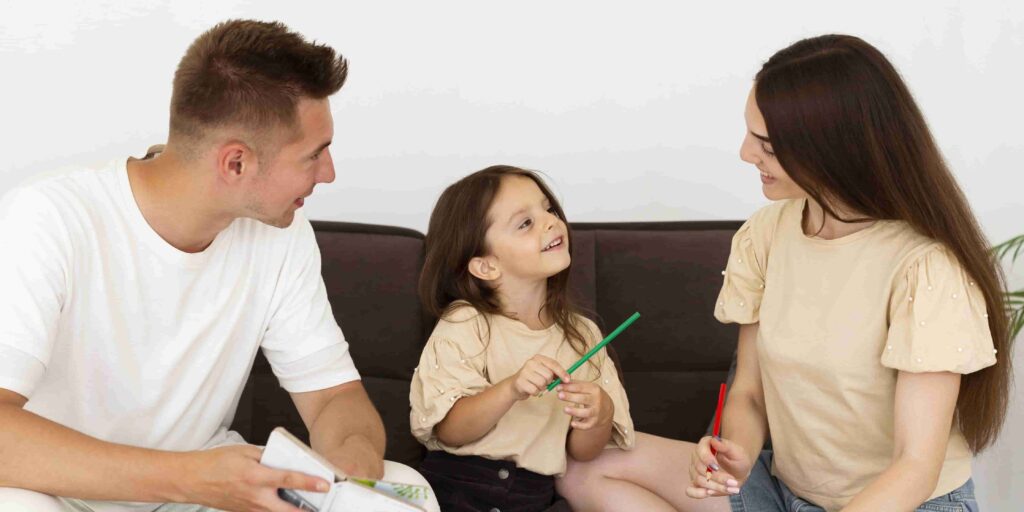
- +61 1300 704 750
- admin@parentinggenie.com.au
- PO Box 706, Townsville, QLD 4810

Genie Chat
In the intricate tapestry of parenthood, one thread stands out as particularly radiant—the art of positive parenting. It’s a practice that transforms the everyday interactions with our children into moments of growth, understanding, and lasting bonds. As parents, we have the incredible power to elevate these interactions, turning them into vibrant brushstrokes on the canvas of our children’s lives. Join us as we delve into the artistry of positive parenting, exploring how simple shifts in perspective and communication can elevate your relationship with your child to new heights.

Positive parenting begins with connection. It’s about more than just being in the same room; it’s about truly being present. It’s the art of listening with not only our ears but our hearts. When your child shares a story from their day, set aside distractions and make them feel valued. Look into their eyes, nod in understanding, and respond genuinely. The art of connection is about creating a safe space where they feel heard, seen, and loved.
Practical Example: During mealtime, put away your phone and other distractions. Engage in a meaningful conversation with your child about their day. Ask open-ended questions and actively listen to their responses.

Positive parenting involves using words that nurture growth and self-esteem. Instead of criticism, use encouragement to fuel your child’s sense of accomplishment. A simple shift in your language can make a profound impact on their confidence. Celebrate their efforts and strengths, highlighting the positive aspects of their actions.
Practical Example: If your child completes a puzzle, instead of saying, “Good job,” say, “I’m impressed by how you persevered and finished that puzzle. You’re becoming a puzzle master!”
Empathy is the foundation of positive parenting. It’s about stepping into your child’s shoes, understanding their feelings, and validating their experiences. When your child is upset, acknowledge their emotions without judgment. Let them know you’re there to support and comfort them.
Practical Example: If your child is upset because they didn’t win a game, say, “I can see you’re feeling disappointed. It’s okay to feel that way. Let’s talk about it.”
Positive parenting involves setting boundaries with love and respect. Boundaries provide a sense of security for children, helping them understand expectations and consequences. Rather than imposing rules arbitrarily, explain the reasons behind them. This approach fosters cooperation and understanding.
Practical Example: If it’s time to put away toys, say, “We need to tidy up our toys before bedtime. When we keep our play area clean, it helps us find things easily.”
Play is not just entertainment—it’s a powerful tool for positive parenting. Engage in imaginative play, creative projects, and shared activities. These moments of play allow you to connect with your child on their level, fostering joy, laughter, and memories that last a lifetime.
Practical Example: Build a fort together using blankets and pillows. Pretend it’s a secret hideaway and create stories or have a tea party inside.
Gratitude is a powerful thread that weaves through positive parenting. Expressing gratitude nurtures appreciation and reinforces the bond between you and your child. When you show gratitude for the little things, you model a positive attitude and encourage them to do the same.
Practical Example: At dinner, go around the table and share something you’re thankful for from the day. It could be a kind gesture, a special moment, or even a delicious meal.
Positive parenting involves treating challenges as opportunities for growth. Encourage your child to be part of the problem-solving process. This approach empowers them to develop critical thinking skills and feel a sense of ownership over the solutions.
Practical Example: If your child forgets their school assignment, ask, “What ideas do you have to make sure you remember your assignment next time?” Let them brainstorm solutions and choose the one that works best for them.
Patience is a cornerstone of positive parenting. It’s about giving your child the time they need to express themselves, learn, and grow. Approach challenges with a calm demeanor, offering support and understanding.
Practical Example: If your child is trying to tie their shoes and struggling, offer encouragement and say, “It’s okay to take your time. You’re doing great, and you’ll get better with practice.”
Above all, positive parenting is grounded in unconditional love. Your child needs to know that your love is unwavering, regardless of their successes or challenges. Show your love through actions, words, and gestures.
Practical Example: Give them a hug and say, “I love you no matter what. You’re special to me just the way you are.”
Every interaction with your child is an opportunity to paint a beautiful picture of positivity, empathy, and love. As parents, we have the incredible privilege of crafting a masterpiece that will shape our children’s lives and relationships for years to come. For more insights, resources, and a supportive community, subscribe to Virtual Parenting Hub. Let’s elevate every interaction and infuse the art of positive parenting into the tapestry of our families’ lives.
Also Read: Balancing Work and Family: Nurturing Your Career and Parenting Responsibilities